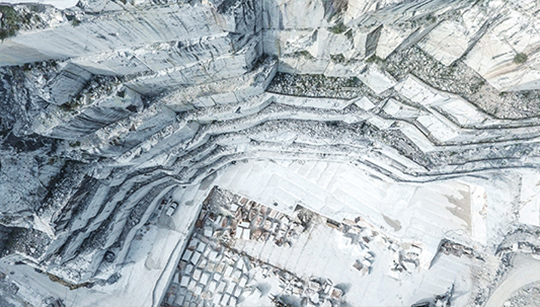Studio 45
Resonate: Architecture, Arts and Acoustics
Sofia Colabella and Michael Mack

This studio is available to students enrolled in ABPL90142 Studio C, ABPL90143 Studio D, and ABPL90115 Studio E.
Studio Description
Sound is a spatial event, a material phenomenon and an auditive experience rolled into one. It can be described using the vectors of distance, direction, and location. Within architecture, every built space can modify, position, reflect or reverberate the sounds that occur there. Sound embraces and transcends the spaces in which it occurs, opening up a consummate context for the listener: the acoustic source and its surroundings unite into a unique auditory experience (Oase 78).
Students will explore the spatial and acoustic qualities of buildings and open-air sites through a set of exercises and by transforming a limestone quarry into a versatile, multi-purpose venue for live music performances. Projects will be informed by concepts of sound propagation and lighting design and will reflect on the necessity to re-align our relationships to one another, and to nature, alongside the idea of silence and noise as strategies to generate different acoustic and spatial experiences.
Studio Outcomes
In the first phase, students will familiarise themselves with acoustic design, design for live performing, and lighting design. By the end of this stage, students are expected to explore sound qualities and lighting performance of spaces generated using Rhinoceros and physical models.
Then, students will design an open-air live performance venue in an abandoned quarry in regional Victoria. By the end of week 12, students are expected to be able to:
- develop the brief and the planning of a live art performance and events venue for a Music Festival;
- simulate acoustic performance and lighting phenomena;
- define and improve the acoustic and lighting qualities of their architectures;
- communicate design ideas and propositions through a variety of media;
- present their work verbally to an external panel of architects and engineers;
- design a live-performing venue at different scales (1:1000 to 1:5).
ESSENTIAL PREREQUISITES: Foundations of analytical thinking. Competency in Rhinoceros and Grasshopper.
Studio Leaders
Dr Sofia Colabella
Dr Sofia Colabella is an architect and Lecturer in Construction Technology in Architecture at ABP (the University of Melbourne). She is the co-founder of 'Gridshell.it', a company specialised in the design and construction of large span and special timber structures. In 2016-2017, as visiting Scientific Partner employed at the EPFL, developed a novel approach to reusing discarded high-tech sports equipment for architecture. In 2019, she got the bronze medal at the Tongji Construction Festival. She is member of the International Association for Shell and Spatial Structures (IASS) and a member of the Hangai Prize committee 2020.
Michael Mack
Michael Mack is a Subject Coordinator, Senior Tutor, and Studio Tutor across a wide range of subjects in the Bachelor of Design and Melbourne School of Design at the University of Melbourne. These include Design Visualisation and Rendering, Digital Design and Fabrication, and Urban Data Analysis. He is also a co-founder of Tinytecture, a set design and model making company combining architecture with a love of craft and fabrication. In 2017, Michael exhibited in the 2017 Bi-City Biennale of Urbanism/Architecture (UABB) with a project investigating and speculating on shared economies and ownership of space.
Readings & References
- Allen & Zalewski, Form and Forces: Designing Efficient, Expressive Structures.
- Arts Victoria, Oh You Beautiful Stage 2012, 2012.
- Barron M., Auditorium Acoustics and Architectural Design. Independence: Routledge; 2009.
- Beranek L., Concert Halls and Opera Houses, Second edition, Springer, 2003.
- Boning W., Bassuet A., A room without walls: optimising an outdoor music shell to maintain views and maximise reflections. Proceedings of the Institute of Acoustics, Vol.37.
- David Byrne: https://ed.ted.com/lessons/how-architecture-helped-music-evolve-david-byrne
- Cox J T., Sonic Wonderland: A Scientific Odyssey of Sound, Penguin Book, 2014.
- Engel H., Structure Systems, 3rd edition, 2007 (1967).
- Fowler M., Architectures of Sound: Acoustic Concepts and Parameters for Architectural Design, Walter de Gruyter GmbH, 2017.
- Holding E., Staged Architecture: The Work of Mark Fisher, Wiley, 2000.
- Nerdinger W., Frei Otto. Complete Works: Lightweight Construction - Natural Design, 2005.
- Long M., Architectural Acoustics. Burlington, Elsevier Science & Technology; 2006.
- Schafer M., Soundscape, Our Sonic Environment and the Tuning of the World. Inner Tradition, 1993.
- Mirra et al, An automated design methodology for acoustic shells in outdoor concerts, 2018.
- Pugnale A., Integrating Form, Structure and Acoustics, IJASS, 2018.
Further references will be provided during the semester.
Schedule Mondays 17:00-20:00, Thursdays 17:00-20:00